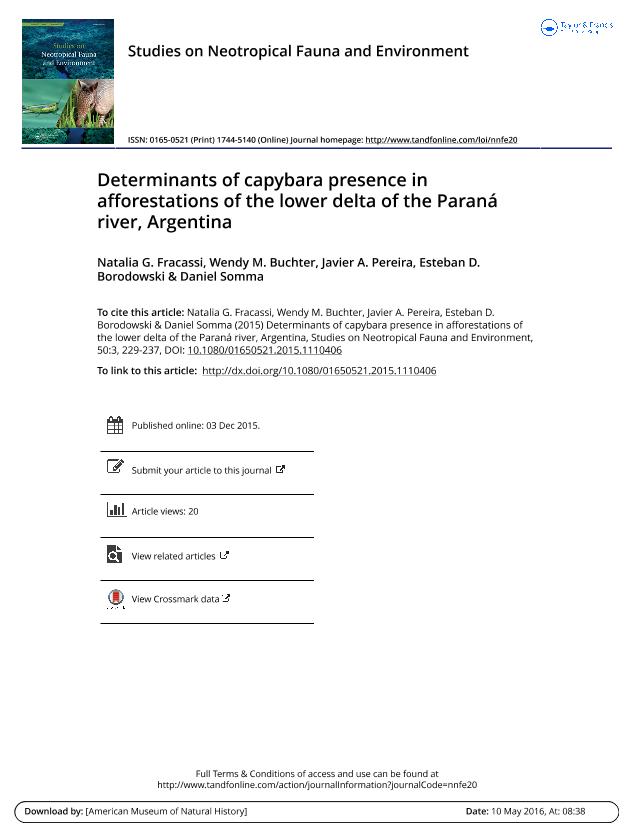Mostrar el registro sencillo del ítem
dc.contributor.author
Fracassi, Natalia G.
dc.contributor.author
Buchter, Wendy M.
dc.contributor.author
Pereira, Javier Adolfo

dc.contributor.author
Borodowski, Esteban D.
dc.contributor.author
Somma, Daniel
dc.date.available
2018-07-30T20:40:55Z
dc.date.issued
2015-09
dc.identifier.citation
Fracassi, Natalia G.; Buchter, Wendy M.; Pereira, Javier Adolfo; Borodowski, Esteban D.; Somma, Daniel; Determinants of capybara presence in afforestations of the lower delta of the Paraná river, Argentina; Taylor & Francis; Studies on Neotropical Fauna and Environment; 50; 3; 9-2015; 229-237
dc.identifier.issn
0165-0521
dc.identifier.uri
http://hdl.handle.net/11336/53498
dc.description.abstract
The delta of the Paraná River in Argentina represents the southernmost stronghold for capybaras (Hydrochoerus hydrochaeris), but this area is highly modified due to commercial afforestations with Salicaceae. Water management (e.g. drainage of marshes) and land protections (e.g. polders) are carried out to improve field conditions for developing afforestations. To assess determinants of capybara presence within polder afforestations, its presence was surveyed in 2011?2013 along with 35 habitat and human-related variables at two spatial scales, in 53 watercourse-side sites. Using logistic regression, a habitat model was developed. Capybaras were present in 52.8% of sites. Water depth at the center of the watercourse had the strongest positive effect on capybara presence, followed by cover of reed marshes and cover of grass bush on the banks. Cover of adult poplar plantations showed a significant negative effect on capybara presence. Watercourses within polder afforestations can provide habitat for capybaras, although their use by these rodents depends on factors interacting at different scales.
dc.format
application/pdf
dc.language.iso
eng
dc.publisher
Taylor & Francis

dc.rights
info:eu-repo/semantics/openAccess
dc.rights.uri
https://creativecommons.org/licenses/by-nc-sa/2.5/ar/
dc.subject
Hydrochoerus Hydrochaeris
dc.subject
Polder Afforestation
dc.subject
Predictive Model
dc.subject
Restoration
dc.subject
Salicaceae
dc.subject
Sustainable Forestry Production
dc.subject.classification
Otras Ciencias Biológicas

dc.subject.classification
Ciencias Biológicas

dc.subject.classification
CIENCIAS NATURALES Y EXACTAS

dc.title
Determinants of capybara presence in afforestations of the lower delta of the Paraná river, Argentina
dc.type
info:eu-repo/semantics/article
dc.type
info:ar-repo/semantics/artículo
dc.type
info:eu-repo/semantics/publishedVersion
dc.date.updated
2018-05-24T14:24:59Z
dc.identifier.eissn
1744-5140
dc.journal.volume
50
dc.journal.number
3
dc.journal.pagination
229-237
dc.journal.pais
Reino Unido

dc.journal.ciudad
Londres
dc.description.fil
Fil: Fracassi, Natalia G.. Instituto Nacional de Tecnología Agropecuaria. Centro Regional Buenos Aires Norte. Estación Experimental Agropecuaria Delta del Paraná; Argentina
dc.description.fil
Fil: Buchter, Wendy M.. Universidad de Buenos Aires. Facultad de Agronomia. Departamento de Producción Vegetal. Cátedra de Dasonomia; Argentina
dc.description.fil
Fil: Pereira, Javier Adolfo. Consejo Nacional de Investigaciones Científicas y Técnicas. Oficina de Coordinación Administrativa Parque Centenario. Museo Argentino de Ciencias Naturales “Bernardino Rivadavia”; Argentina
dc.description.fil
Fil: Borodowski, Esteban D.. Universidad de Buenos Aires. Facultad de Agronomia. Departamento de Producción Vegetal. Cátedra de Dasonomia; Argentina
dc.description.fil
Fil: Somma, Daniel. Instituto Nacional de Tecnología Agropecuaria. Centro Regional Buenos Aires Norte. Estación Experimental Agropecuaria Pergamino; Argentina
dc.journal.title
Studies on Neotropical Fauna and Environment

dc.relation.alternativeid
info:eu-repo/semantics/altIdentifier/url/https://www.tandfonline.com/doi/full/10.1080/01650521.2015.1110406
dc.relation.alternativeid
info:eu-repo/semantics/altIdentifier/doi/http://dx.doi.org/10.1080/01650521.2015.1110406
Archivos asociados
